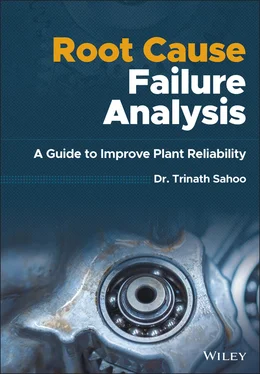Trinath Sahoo - Root Cause Failure Analysis
Здесь есть возможность читать онлайн «Trinath Sahoo - Root Cause Failure Analysis» — ознакомительный отрывок электронной книги совершенно бесплатно, а после прочтения отрывка купить полную версию. В некоторых случаях можно слушать аудио, скачать через торрент в формате fb2 и присутствует краткое содержание. Жанр: unrecognised, на английском языке. Описание произведения, (предисловие) а так же отзывы посетителей доступны на портале библиотеки ЛибКат.
- Название:Root Cause Failure Analysis
- Автор:
- Жанр:
- Год:неизвестен
- ISBN:нет данных
- Рейтинг книги:5 / 5. Голосов: 1
-
Избранное:Добавить в избранное
- Отзывы:
-
Ваша оценка:
- 100
- 1
- 2
- 3
- 4
- 5
Root Cause Failure Analysis: краткое содержание, описание и аннотация
Предлагаем к чтению аннотацию, описание, краткое содержание или предисловие (зависит от того, что написал сам автор книги «Root Cause Failure Analysis»). Если вы не нашли необходимую информацию о книге — напишите в комментариях, мы постараемся отыскать её.
Provides the knowledge and failure analysis skills necessary for preventing and investigating process equipment failures Root Cause Failure Analysis: A Guide to Improve Plant Reliability
Root Cause Failure Analysis: A Guide to Improve Plant Reliability
Root Cause Failure Analysis — читать онлайн ознакомительный отрывок
Ниже представлен текст книги, разбитый по страницам. Система сохранения места последней прочитанной страницы, позволяет с удобством читать онлайн бесплатно книгу «Root Cause Failure Analysis», без необходимости каждый раз заново искать на чём Вы остановились. Поставьте закладку, и сможете в любой момент перейти на страницу, на которой закончили чтение.
Интервал:
Закладка:
What is the problem?
When did it happen?
Where did it happen? and
How did it impact the goals?
The investigator or the RCA analyst seldom present when an incident or failure occurs. Therefore, the first information report or FIR is the initial notification that an incident or failure has taken place. In most cases, the communication will not contain a complete description of the problem. Rather, it will be a very brief description of the perceived symptoms observed by the person reporting the problem.
It involves failure reporting regarding incident which includes details of failure time, place, nature of failure, and failure impacts on organization.
Consider a problem on a centrifugal pump AC Motor. A typical problem report could state “pump ABC motor has a problem”. Even though this type of problem reporting could be worse, for example, “fan is bad” or “shrill noise from one of the pumps.” “Pump ABC Motor has a problem” it is still not a very good definition.
A better definition may be “AC Motor of pump ABC” is hot. Can we do better with some basic Root Cause Analysis steps? Sure! Let’s ask the traditional, WHAT, WHERE, WHEN, EXTENT. The problem is:
What: AC Motor of pump ABC (already answered) Where: Motor is hot close to the front (belt drive side) When: Don’t know exactly, but 7 days ago a 138 F reading was recorded (normal) Extent: Front of motor is running 210 F.
The above definition is usually enough to get a problem started. Is it ideal? Perhaps not, but it’s pretty good for a problem statement. This level of problem reporting for craftspeople and operators would be a huge improvement for most plants in improving day‐to‐day Root Cause Analysis.
Collection of data
Data collection is the second and important phase of RCA process. Acquiring, gathering, or collecting the failure data regarding the incident are a key for getting the valuable results of RCA investigation. Comprehensive and relevant failure data are crucial to identify and understand the root causes of a failure accurately. Unavailability of correct, adequate, and sufficient data can lead to undesired results of RCA.
It is important to collect data immediately after occurrence of failure for accurate information and evidence collection before the data is lost. The information that should be collected consists of personnel involved; conditions before, during, and after the event; environmental factors; and other information required for root cause analysis process.
Every effort should be made to preserve physical evidence such as failed components, ruptured gaskets, burned leads, blown fuses, spilled fluids, partially completed work orders, and procedures. Event participants and other knowledgeable individuals should be identified. All work orders and procedures must be preserved and effort should be made to preserve physical evidence such as failed components and ruptured gaskets. After the data associated with the event have been collected, the data should be verified to ensure accuracy.
Data for any failure could include the previous failure reports, maintenance, and operations data, process data, drawings, design, physical evidences, failed part of equipment and any other necessary information related to the particular failure. It is not necessary that every failure required comprehensive data but sometimes data could be missing and gathered data is not sufficient to identify actual causes of the failure. So it is necessary that collected data must be accurate and relevant. Failure can’t be investigated properly without availability of correct and related data. Usually, data collection consumes more time as compare to other steps of RCA process so data must be precise and meaningful for identifying the exact causes of failure. Information collected from gathered data is significant for making recommendation and conclusions.
When investigating an incident involving equipment failure, the first job is to preserve the physical evidence. The instrumentation and control settings and the actual reading before the failure happen should be fully documented for the investigating team. In addition, the operating and process data, approved standard operating (SOP) and standard maintenance procedure (SMP), Copies of log books, work packages, work orders, work permits, and maintenance records; eq should be preserved.
Some methods of gathering information include:
Conducting interviews/collecting statements – Interviews must be fact finding and not fault finding. Preparing questions before the interview is essential to ensure that all necessary information is obtained.
Interviews should be conducted, preferably in person, with those people who are most familiar with the problem. Although preparing for the interview is important, it should not delay prompt contact with participants and witnesses. The first interview may consist solely of hearing their narrative. A second, more‐detailed interview can be arranged, if needed. The interviewer should always consider the interviewee’s objectivity and frame of reference.
Reviewing records: Review of relevant documents or portions of documents and reference their use in support of the root cause analysis.
Acquiring related information: Some additional information that an evaluator should consider when analyzing the causes include:
Evaluating the need for laboratory tests, such as destructive/nondestructive failure analysis.
Viewing physical layout of system, component, or work area; developing layout sketches of the area; and taking photographs to better understand the condition.
Determining if operating experience information exists for similar events at other facilities.
Reviewing equipment supplier and manufacturer records to determine whether correspondence has been received addressing this problem.
Interviews
For critical incidents, all key personnel involved must be interviewed to get a complete picture of the incident. Individuals having direct or indirect knowledge that could help clarify the case should also be interviewed.
Questions to Ask
What happened?
Where did it happen?
When did it happen?
What changed?
Who was involved?
Why did it happen?
What is the impact?
How can recurrence be prevented?
Analyze Sequence of Events
The sequence of event helps in finding out which cause has first triggered the incident. This helps in organizing the information and establishes relationship between the event and incident.
Design Review
It is essential to clearly understand the design parameters and specifications of the systems associated with an event or equipment failure. Unless the investigator understands precisely what the machine or production system was designed to do and its inherent limitations, it is impossible to isolate the root cause of a problem or event. The data obtained from a design review provide a baseline or reference, which is needed to fully investigate and resolve plant problems.
The objective of the design review is to determine whether the machine is running within acceptable operating envelope. The condition of the machine and the process condition are being investigated. For example, a centrifugal pump may be designed to deliver 1OOO m 3/h of water having a discharge Pressure of 20 kg/cm 2. If it is operated beyond this point, then the power will increase and due to running beyond design limit vibration may go up. The review should establish the acceptable operating envelope, or range, that the machine or system can tolerate without a measurable deviation from design performance. Evaluating variations in process parameters, such as pressures flow rate, and temperature, is an effective means of confirming their impact on the production system.
Читать дальшеИнтервал:
Закладка:
Похожие книги на «Root Cause Failure Analysis»
Представляем Вашему вниманию похожие книги на «Root Cause Failure Analysis» списком для выбора. Мы отобрали схожую по названию и смыслу литературу в надежде предоставить читателям больше вариантов отыскать новые, интересные, ещё непрочитанные произведения.
Обсуждение, отзывы о книге «Root Cause Failure Analysis» и просто собственные мнения читателей. Оставьте ваши комментарии, напишите, что Вы думаете о произведении, его смысле или главных героях. Укажите что конкретно понравилось, а что нет, и почему Вы так считаете.












